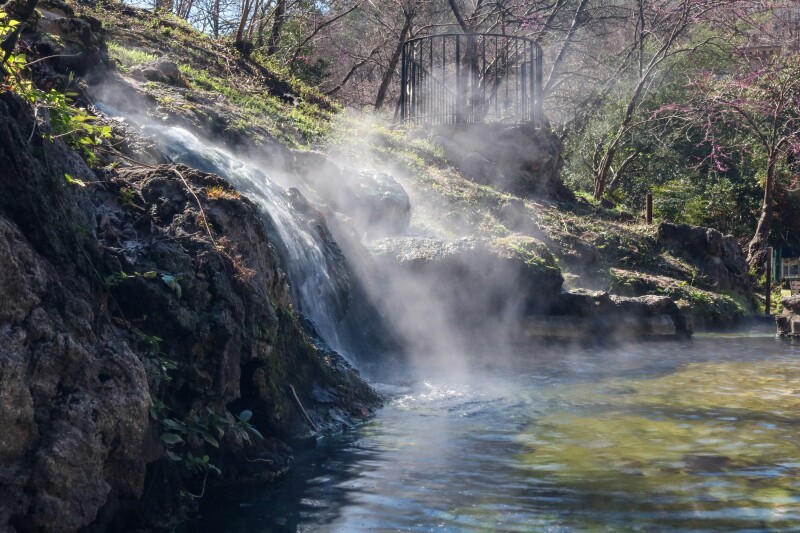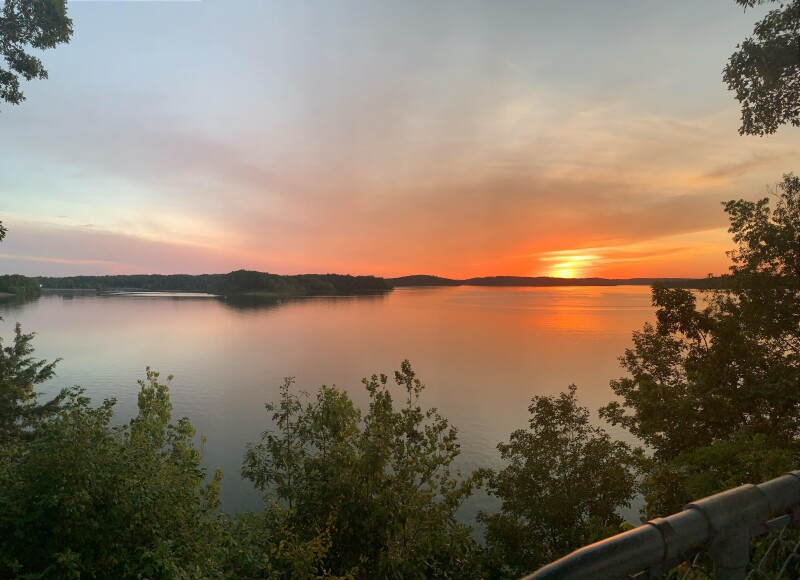Pairing the solar eclipse, which comes around on April 8, with the open space of a state or national park seems like a no-brainer. After all, what better way to experience a breathtaking celestial phenomenon than surrounded by equally awe-inspiring nature?
Within the United States, two national parks—Hot Springs National Park and Cuyahoga Valley National Park—and more than 100 state parks will be on the path of totality as it makes its way across Texas, Arkansas, Missouri, Kentucky, Illinois, Indiana, Ohio, Pennsylvania, New York, Vermont, New Hampshire, and Maine.
If you’re planning for the 2024 solar eclipse but still aren’t sure where to go, here are seven of the best state and national parks for witnessing the event.

Hot Springs National Park covers more than 5,000 acres.
Photo by Bram Reusen/Shutterstock
1. Hot Springs National Park, Arkansas
One of the smallest national parks in the United States is also one of the luckiest: Hot Springs National Park in Hot Springs, Arkansas, is going to be one of just two national parks experiencing totality (when the moon completely blocks the face of the sun, turning the skies dark). For the best views, the 5,550-acre park has more than 25 miles of hiking trails of varying difficulties for a more active form of relaxation, ranging from the easy, 1.7-mile Hot Springs Mountain Trail to the 10-mile Sunset Trail. And then reward yourself by experiencing the area’s thermal water in the two bathhouses downtown. If you’d rather save the panoramas of the Ouachita Mountains for after the eclipse, the city of Hot Springs has its own lineup of watch parties and concerts.

Visit the 60-foot Brandywine Falls on your solar eclipse trip to Cuyahoga National Park.
Photo by Shriram Patki/Shutterstock
2. Cuyahoga Valley National Park, Ohio
Cuyahoga Valley National Park, located in northeastern Ohio, is one of the country’s most frequented national parks; it was the ninth most-visited in 2022. It’s also set to experience a relatively long time in total darkness—about four minutes, starting around 3:13 p.m. If you don’t want to wait until 2099 for the next total solar eclipse to pass over Ohio, stake a daytime spot in the nearly 33,000-acre national park. For a scenic place to watch the eclipse, head to the 1.8-mile Oak Hill Trail or visit Beaver Marsh and catch the namesake animal swimming along the wetlands.
If you’re a fan of scenic train trips, you can explore the area before or after the eclipse aboard the Cuyahoga Valley Scenic Railroad’s National Park Scenic Excursion.

The 8,400-acre Lake Wappapello is popular for boating and fishing.
Photo by Rebecca L Williams/Shutterstock
3. Lake Wappapello State Park, Missouri
April’s solar eclipse will cut through southeastern Missouri, making totality visible in 14 of its state parks. The 1,854-acre Lake Wappapello State Park in Williamsville is one of them; it is set to have one of the longest totality periods among the parks with more than four minutes of darkness. The park sits on the shores of the 8,400-acre reservoir, where fishers cast lines for crappie, bass, and catfish—especially in April, the middle of peak fishing season. See the eclipse roll in with some waterfront views along the .7-mile Lake View Trail or on the 2.6-mile Asher Creek Trail.

Enjoy the Frio River on a trip to Garner State Park.
Photo by Richard McMillon/Shutterstock
4. Garner State Park, Texas
Texas is going to be a hot spot for eclipse chasers this spring, as totality will be visible for many of its big cities: San Antonio, Austin, and Dallas among them. The sloping terrain of Texas’s Hill Country is going to have some of the best places to catch the eclipse, one of them being the 1,774-acre Garner State Park. There are more than 15 trails to explore, as well as a 2.9-mile segment of the Frio River ideal for a lazy float or paddle boat. The park will get nearly four and a half minutes of totality—so visitors will get a long bout of total darkness. Beyond the eclipse, wander through the landscapes and small towns of Texas Hill Country and discover why this region is one of AFAR’s best places to go in 2024.

Every second, more than 3,000 tons of water flow over Niagara Falls.
Courtesy of rodtcs/Unsplash
5. Niagara Falls State Park, New York
On April 8, travel to the Canadian border and you can witness the solar eclipse in Niagara Falls State Park. America’s oldest state park is going to get nearly four minutes of totality on eclipse day, plus some science-y fun: Starting on April 4, NASA experts (including astronauts) will host free, public events in the park and throughout the city the weekend leading up to the solar eclipse. When it comes to viewpoints, the park anticipates Terrapin Point, Prospect Point, and Luna Island as being some of the more popular places, although icy conditions may limit access to these spots. There may even be a chance to witness the eclipse aboard the Maid of the Mist, depending on weather conditions.

As an alternative to Presque Isle State Park, drive 20 minutes southwest to Erie Bluffs State Park.
Photo by Jacob Tobolewski/Shutterstock
6. Erie Bluffs State Park, Pennsylvania
A sliver of Pennsylvania’s northwest corner will experience the total solar eclipse on April 8, and within it, four state parks get totality: Presque Isle State Park, Erie Bluffs State Park, Pymatuning State Park, and Maurice K. Goddard State Park. Because people are predicted to come in droves, some places are preparing for the crowds: Erie’s tourism board is recommending against visiting Presque Isle State Park in particular, which has only one entry and exit point. As an alternative, consider the 587-acre Erie Bluffs State Park, which provides a solar eclipse setting of wide, open coastline set against 90-foot bluffs, to see the approximately three minutes and 40 seconds of totality.

Niquette Bay State Park is located beside Malletts Bay, which connects to Lake Champlain.
Courtesy of Megan Swanson/Unsplash
7. Niquette Bay State Park, Vermont
Although Burlington, Vermont, and the surrounding area are known for fantastic foliage in the fall, the upper half of Vermont could make a great spring trip—it’s on the path of totality. Twenty minutes north of Burlington, Niquette Bay State Park is a central point to explore the state and experience nearly three and a half minutes of totality. The 584-acre park offers varied landscapes to view the event, whether you want to see it lakeside on a trail by Lake Champlain or among the Green Mountains. Another nearby option for eclipse chasers: Ski resorts Stowe Mountain Resort and Smugglers’ Notch Resort are within an hour’s drive from the state park, offering elevated views of the phenomenon. After the eclipse, consider driving 30 minutes southeast to the charming small town of Waterbury, home to delicious culinary offerings (did I mention the Ben & Jerry’s Factory is located here?)











